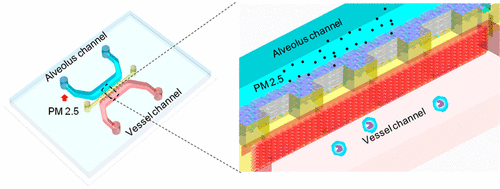当前位置:
X-MOL 学术
›
ACS Biomater. Sci. Eng.
›
论文详情
Our official English website, www.x-mol.net, welcomes your feedback! (Note: you will need to create a separate account there.)
Assessment of Air Pollutant PM2.5 Pulmonary Exposure Using a 3D Lung-on-Chip Model
ACS Biomaterials Science & Engineering ( IF 5.8 ) Pub Date : 2020-03-24 , DOI: 10.1021/acsbiomaterials.0c00221 Cong Xu 1, 2 , Min Zhang 1, 2 , Wenwen Chen 1, 2 , Lei Jiang 1 , Chunying Chen 3 , Jianhua Qin 1, 2, 4, 5
ACS Biomaterials Science & Engineering ( IF 5.8 ) Pub Date : 2020-03-24 , DOI: 10.1021/acsbiomaterials.0c00221 Cong Xu 1, 2 , Min Zhang 1, 2 , Wenwen Chen 1, 2 , Lei Jiang 1 , Chunying Chen 3 , Jianhua Qin 1, 2, 4, 5
Affiliation

|
Airborne particulate matters have posed significant risk to human health worldwide. Fine particulate matters (PM2.5, aerodynamic diameter <2.5 μm) are associated with increased morbidity and mortality attributed to pulmonary diseases. An advanced in vitro model would benefit the assessment of PM2.5 induced pulmonary injuries and drug development. In this work, we present a PM2.5 exposure model to evaluate the pulmonary risk of fine particulate matter exposure in an organotypic manner with the help of 3D human lung-on-a-chip. By compartmentalized co-culturing of human endothelial cells, epithelial cells, and extra cellular matrix, our lung-on-a-chip recapitulated the structural features of the alveolar–blood barrier, which is pivotal for exogenous hazard toxicity evaluation. PM2.5 was applied to the channel lined with lung epithelial cells to model the pulmonary exposure of fine particulate matter. The results indicated acute high dose PM2.5 exposure would lead to various malfunctions of the alveolar–capillary barrier, including adheren junction disruption, increased ROS generation, apoptosis, inflammatory biofactor expression in epithelial cells and endothelial cells, elevated permeability, and monocyte attachments. Collectively, our lung-on-a-chip model provides a simple platform to investigate the complex responses after PM2.5 exposure in a physiologically relevant level, which could be of great potential in environmental risk assessment and therapeutic treatment development.
中文翻译:

使用3D肺片模型评估空气污染物PM2.5肺暴露
空气中的颗粒物已对全球人类健康构成了重大风险。细颗粒物(PM2.5,空气动力学直径<2.5μm)与归因于肺部疾病的发病率和死亡率增加有关。先进的体外该模型将有助于评估PM2.5诱发的肺损伤和药物开发。在这项工作中,我们提出了一个PM2.5暴露模型,以借助3D人类片上肺以器官型方式评估细颗粒物暴露的肺部风险。通过人内皮细胞,上皮细胞和细胞外基质的区室化共培养,我们的单片肺重现了肺泡-血液屏障的结构特征,这对于外源性危害毒性评估至关重要。将PM2.5应用于衬有肺上皮细胞的通道,以模拟肺中细颗粒物质的暴露。结果表明,急性高剂量PM2.5暴露会导致肺泡-毛细血管屏障的各种功能异常,包括粘附连接破坏,ROS生成增加,细胞凋亡,上皮细胞和内皮细胞中炎症生物因子的表达,通透性增加和单核细胞附着。总的来说,我们的单芯片肺模型提供了一个简单的平台,可在生理相关水平上研究PM2.5暴露后的复杂反应,这可能在环境风险评估和治疗开发中具有巨大潜力。
更新日期:2020-03-24
中文翻译:

使用3D肺片模型评估空气污染物PM2.5肺暴露
空气中的颗粒物已对全球人类健康构成了重大风险。细颗粒物(PM2.5,空气动力学直径<2.5μm)与归因于肺部疾病的发病率和死亡率增加有关。先进的体外该模型将有助于评估PM2.5诱发的肺损伤和药物开发。在这项工作中,我们提出了一个PM2.5暴露模型,以借助3D人类片上肺以器官型方式评估细颗粒物暴露的肺部风险。通过人内皮细胞,上皮细胞和细胞外基质的区室化共培养,我们的单片肺重现了肺泡-血液屏障的结构特征,这对于外源性危害毒性评估至关重要。将PM2.5应用于衬有肺上皮细胞的通道,以模拟肺中细颗粒物质的暴露。结果表明,急性高剂量PM2.5暴露会导致肺泡-毛细血管屏障的各种功能异常,包括粘附连接破坏,ROS生成增加,细胞凋亡,上皮细胞和内皮细胞中炎症生物因子的表达,通透性增加和单核细胞附着。总的来说,我们的单芯片肺模型提供了一个简单的平台,可在生理相关水平上研究PM2.5暴露后的复杂反应,这可能在环境风险评估和治疗开发中具有巨大潜力。


























 京公网安备 11010802027423号
京公网安备 11010802027423号